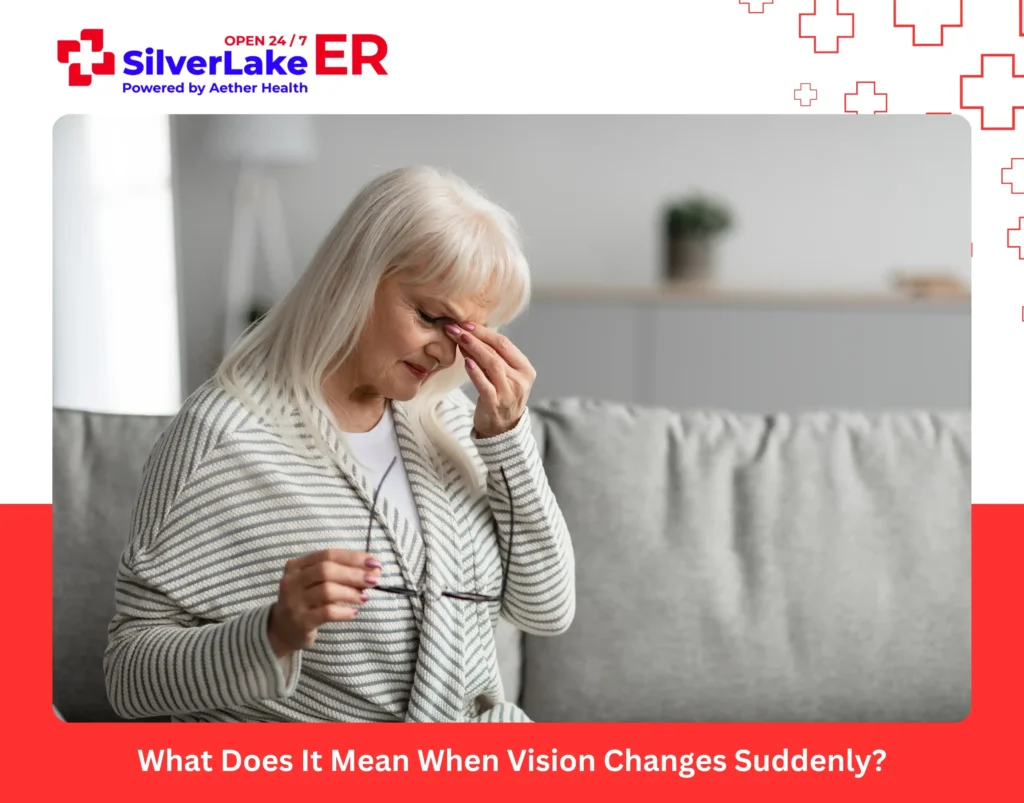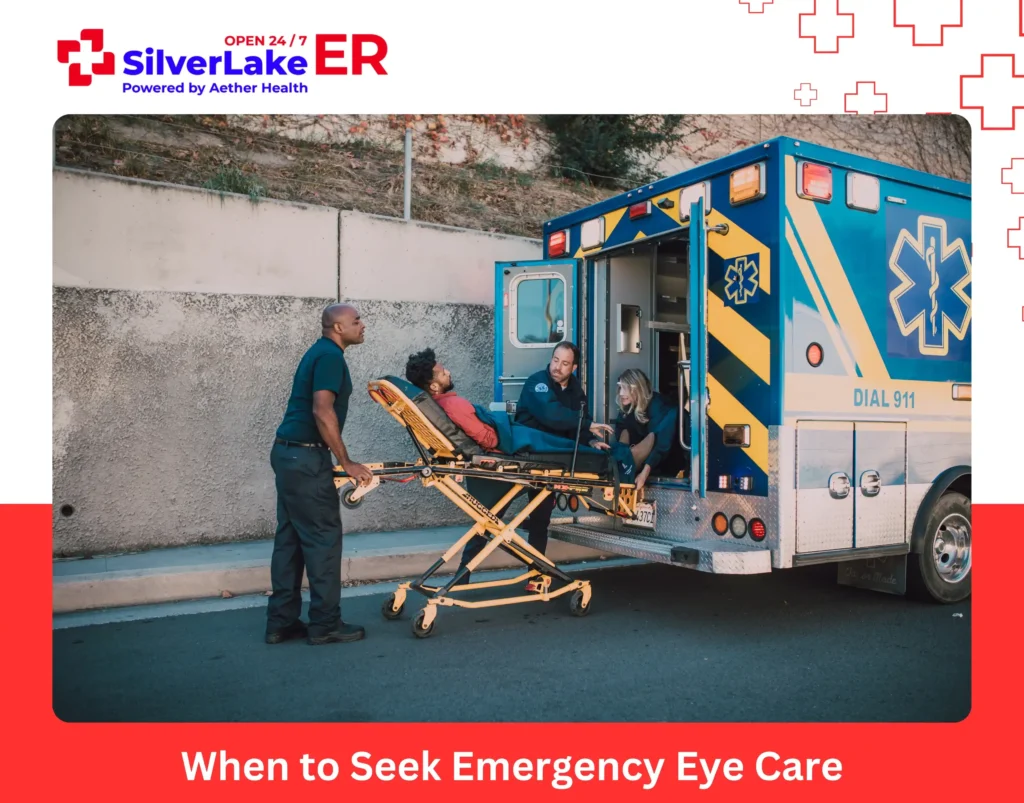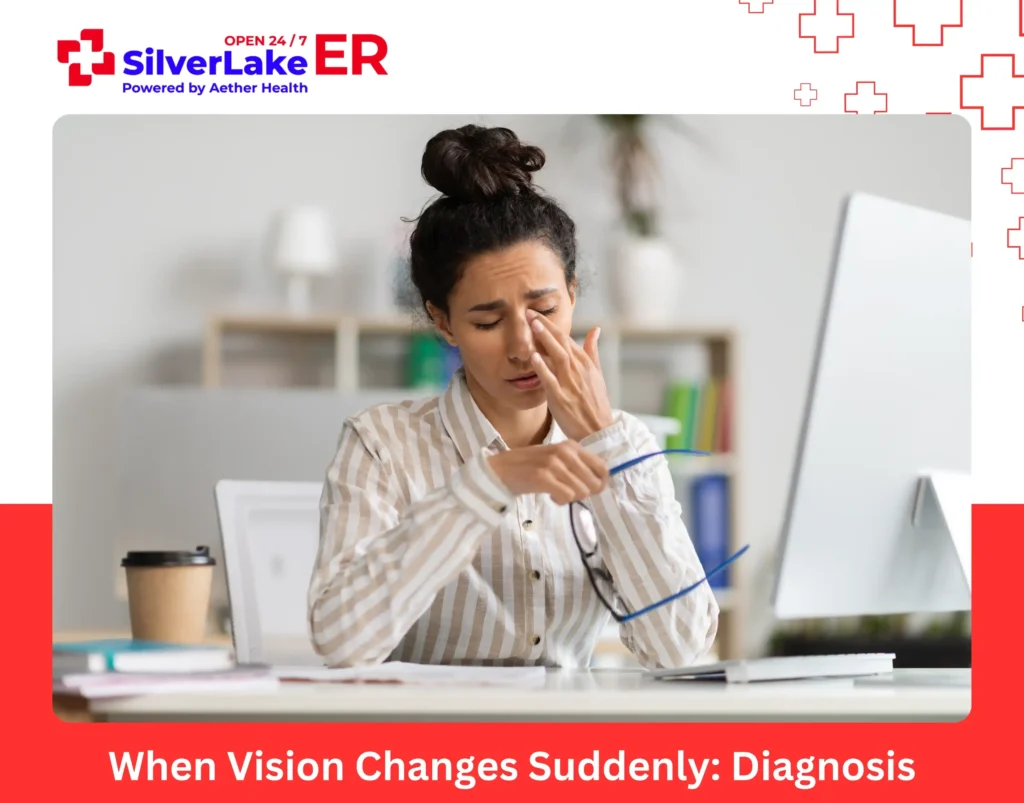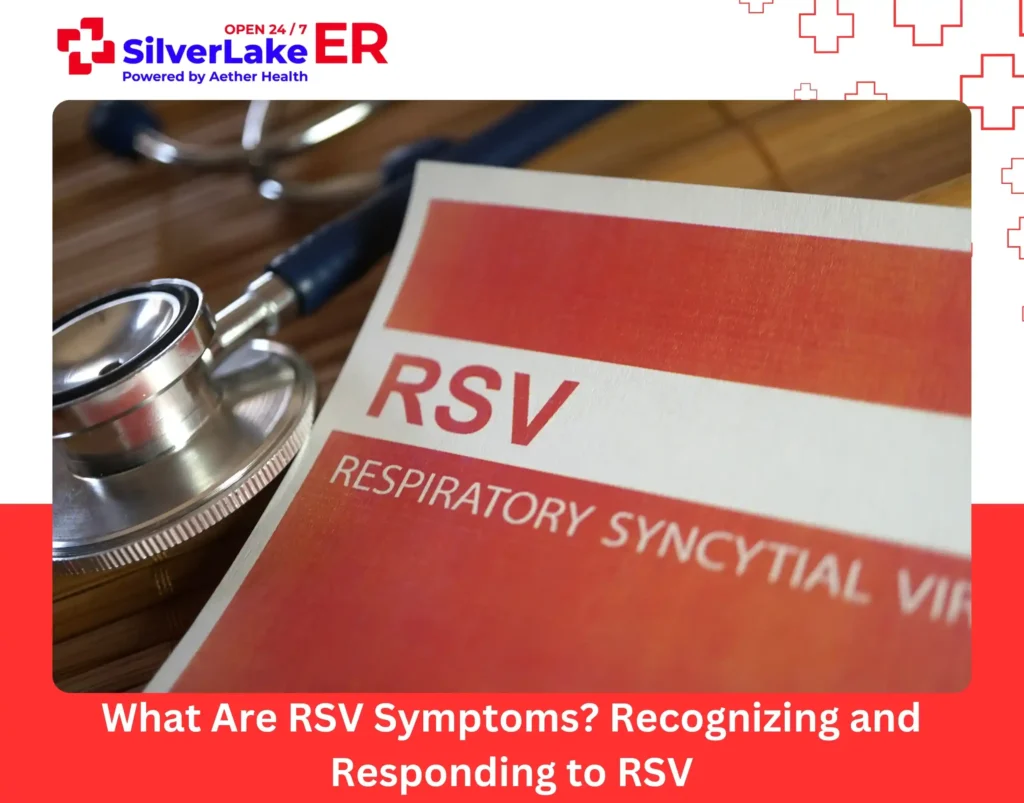Ignoring sudden vision changes could be your biggest mistake. Not always does it mean “I need new glasses.” Sometimes it could be a serious eye condition that could lead to permanent vision loss.
Most of these serious causes are painless. That’s why people wait too long to get help. But if you know why and when vision changes suddenly, you’re more likely to act fast and save your eyesight.
In this post, we’ll walk through the causes of sudden vision changes, help you spot the warning signs, and explain why it’s important to treat sudden vision changes as medical emergencies.
What Does It Mean When Vision Changes Suddenly?

Sudden vision changes signal that something is disrupting the normal pathway from your eyes to your brain. These disruptions can occur at different points: the eye itself, the optic nerve, or the brain’s visual processing centers.
Vision changes can affect one or both of your eyes and may last for a few minutes, seconds, or longer. Some causes are minor and resolve on their own, but others can be serious and require emergency eye care.
Sudden vs Gradual Vision Changes
Vision changes that occur gradually are often related to aging, eye strain, or eye problems such as cataracts. These are not emergencies.
However, if your vision was normal yesterday but blurry today, or if you suddenly lose part of your vision, it is a red flag.
Common Visual Problems to Watch For
When your vision changes suddenly, you might notice:
- Blurred vision (everything looks out of focus)
- Double vision (seeing two of the same object)
- Flashing lights or zigzag patterns
- Black spots or floaters moving across your view
- A dark shadow or curtain-like effect over part of your sight
- Sudden vision loss in one or both eyes
Harmless Causes of Sudden Vision Changes
Sudden vision changes do not always have one clear cause. They can originate from problems within the eye itself or from issues in the brain or nerves that control vision. Let’s start with the less serious causes, which are usually short-lived and manageable:
1. Eye Strain
When you spend hours staring at a phone or laptop screen, your eyes can get tired and dry, leading to blurry vision. Resting your eyes and using artificial tears usually helps.
2. Migraine with Aura
Sometimes, vision changes suddenly because of a migraine, even if you don’t feel any head pain. It usually goes away in 20–60 minutes.
Visual symptoms may include:
- Flashing lights
- Zigzag lines
- Temporary blurred vision or blind spots
3. Low Blood Sugar
Diabetics, especially, can experience blurred vision when glucose drops. Eating a quick snack usually brings things back to normal.
Severe Cause of Sudden Vision Changes
The following conditions require emergency care:
1. Retinal Detachment
The retina is a thin layer at the back of your eye that helps you see. If it pulls away from its normal position, you can suddenly lose part or all of your vision.
Symptoms:
- Bright flashes of light
- A sudden shower of floaters (tiny black or gray dots)
- A dark shadow or “curtain” moving over part of your vision
2. Eye Stroke (Retinal Artery Occlusion)
An eye stroke happens when the blood flow to your retina is suddenly blocked. This is similar to a stroke in the brain, but it affects your eye.
Symptoms:
- Sudden blindness or major vision loss in one eye
- Often painless
- It may happen right after waking up
3. Trauma and Eye Injuries
A head injury or direct injury to the eye can instantly create vision problems. Depending on the force and location of the injury, trauma may cause:
- Bleeding inside the eye
- Retinal detachment
- Increased eye pressure
- Fractures around the eye socket
4. Optic Neuritis
This is inflammation of the optic nerve, often linked to autoimmune conditions like multiple sclerosis.
Symptoms:
- Sudden vision loss in one eye
- Eye pain, especially when moving your eye
- Colors look “washed out” or dull.
5. Giant Cell Arteritis
This is a condition where blood vessels in the head become inflamed and narrowed, cutting off blood flow to the eyes. If your vision changes suddenly especially with painless loss of vision in one eye it could be a red flag. Other symptoms include:
- Tenderness in the scalp or temples
- Jaw pain when chewing
- Fever or fatigue in older adults
Important: If not treated right away, these issues can lead to permanent blindness. It’s often painless, so don’t wait for it to hurt and go to the ER.
When to Seek Emergency Eye Care

If you experience any of the following symptoms, get emergency eye care as soon as possible:
- Sudden vision loss in one or both eyes: Losing vision suddenly in one or both eyes is a medical emergency and can be caused by retinal detachment, eye stroke, blood vessel blockage, or optic nerve damage.
- Eye pain or pressure with vision changes: Pain or pressure inside the eye along with vision changes could mean inflammation, infection, or injury to the eye.
- Trouble speaking or moving alongside vision problems: Vision changes are not just about the eyes; they may point to something with your brain.
If the symptoms are not accompanied by pain or other warning signs, schedule an appointment with an ophthalmologist. They can check for less severe causes and help you manage your vision problems safely.
What Information to Share With Your Doctor
When you arrive at the ER, your doctor will need key details to figure out what’s happening. Try to note:
- When your vision changed (exact time or rough estimate)
- Whether it happened suddenly or gradually
- If it affected one or both eyes
- Any other symptoms (headache, numbness, dizziness, eye pain)
- Any recent trauma or injury
- Medications or health conditions (like high blood pressure, diabetes, migraines)
When Vision Changes Suddenly: Diagnosis

When you come to the emergency room with sudden vision problems, the medical team moves quickly to figure out what’s going on. Here’s how the diagnosis process works:
- Quick Triage: A nurse will ask about your symptoms, medical history, and how fast things changed.
- Eye Exam: You’ll get tested for visual acuity (how well you see letters on a chart), pupil response, and field of vision.
- Imaging: On‑site imaging like CT scans or specialized retinal scans helps doctors see what’s happening inside your eye and brain.
- Initial Treatment: Depending on the cause, this could mean medication for inflammation, blood pressure control, or pain management to stabilize your condition.
- Specialist Coordination: For conditions requiring specialized eye procedures or surgery, we coordinate immediate transfer to ophthalmology specialists or hospitals equipped for advanced eye care.
Final Thoughts: Don’t Risk Your Sight
When vision changes suddenly, emergency eye care can mean the difference between saving your sight and losing it. Conditions like retinal detachment take hours, not days, to cause permanent damage.
But the good news is, modern emergency rooms are equipped to diagnose and treat vision emergencies effectively. So the next time your world goes fuzzy, head straight to the ER. Silverlake ER is ready 24/7 to run urgent tests, provide fast treatment, and help protect your vision. Walk in anytime, no appointment needed.
FAQs
1: Can blurred vision mean something serious?
Yes, but not every time. While blurred vision is often caused by tired eyes or the need for glasses, it can also be a warning sign of an eye stroke, retinal detachment, or high eye pressure.
2: What’s the difference between sudden blindness and vision loss?
Sudden blindness usually means you can’t see at all out of one or both eyes. Sudden vision loss can include partial loss, such as a dark spot or missing area in your field of vision.
3: What’s the first thing I should do if I notice a dark spot or flashing light?
Stop what you’re doing and pay attention to the symptoms. These can be signs of retinal detachment or other serious issues. Try not to rub your eyes or ignore the problem. If the dark spot or flashing lights don’t go away within a few minutes, seek emergency eye care immediately.
4: Can stress or anxiety cause vision changes suddenly?
Yes, stress and anxiety can sometimes cause temporary visual disturbances like blurred vision or light sensitivity. This is usually due to tension, changes in breathing, or a panic attack.




